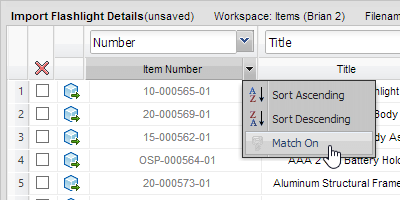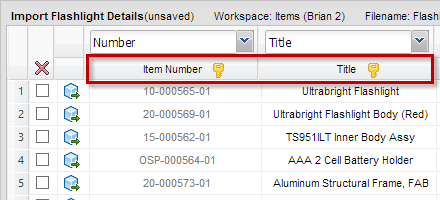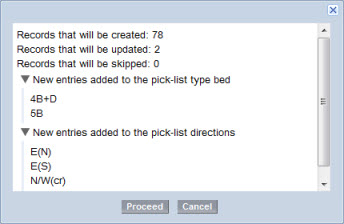Import Item Details
Use an import project to import item details into a workspace.
Set Up the Import Project
- Create an Item Details Import Project, OR
- Edit a saved item details import project:
- From the navigation menu, select Advanced Tools > Imports.
- In the My Import Projects table, click Edit to configure an import project.
Map Item Properties to Workspace Fields
On the Edit Import page, map the incoming item data to corresponding workspace fields.

To map the incoming Excel values to the corresponding workspace fields, select the field in the drop-down list above each Excel column.
If a column header in your Excel file matches a field on the item details tab, it is automatically mapped to the corresponding field.
Read-only fields
You can import data to read-only fields. These are fields with the Editable value set to False or Creation Only. Data imported to these fields is protected the same way as data in other read-only fields. You are warned that the field cannot be edited after importing, but you can proceed with the import. For help on field types, see Configure Forms and Views.
Note: You cannot map system-generated fields such as Auto Number and Computed.Filtered Picklist Fields
You can import data to filtered picklist fields. The mapping is validated by verifying that import values as well the combination of multiple values are valid. If not, you can choose to error out or use blanks to complete the import. In addition, when you import some values in a combination that result in a single option for another field in the combination, the import automatically populates the field with the correct value.
Multi-Select Picklist Fields
You can import data to multi-select picklists. Values in a multi-select picklist are delimited with a comma (,). A comma within a value must be preceded with a backslash (\) to differentiate it from the delimiter comma. For example: Doe\, John,Doe\, Jane. The values "Doe, John" and "Doe, Jane" contain escaped commas and are delimited by a single comma without the escape character.
Click a header in the mapping table and select Match On to indicate that you want incoming values in the column matched against existing item values.
The values in the Match On columns are compared with the corresponding fields. If the values match, the record is updated. If the values do NOT match, a new record is created in the workspace.
Note: A Match On key must be specified that uniquely identifies each item. Multiple numeric and text fields can be specified.

Import Classification Properties
You can import classification properties if the selected workspace has classifications enabled and the Excel worksheet includes classification data. One column in the Excel file must contain the system name of the class to which each item belongs. The column must be mapped as the class entry column in the import table. Fusion Manage attempts to map incoming fields to those in Classification Manager.
- Locate the column containing the classification system names. From the drop-down list above the column, select Class. This identifies the column as containing class system names.
- Locate a column containing classification properties. From the drop-down list above the column, select Field.
- The Choose Field dialog lists the system names for the classification fields in the workspace. Select the classification field to which the incoming property will be assigned and then click Select. Repeat this step for each classification property to be imported.
Edit Data Before Importing
Click a cell to edit the value. A red mark in the cell indicates that the value was changed.

To mark a row for deletion, click the
 checkbox in the second column.Note: Rows deleted from the project cannot be recovered. To retrieve deleted rows, start a new project and reload the Excel file.
checkbox in the second column.Note: Rows deleted from the project cannot be recovered. To retrieve deleted rows, start a new project and reload the Excel file.Click Save to apply the edits, remove the rows marked for deletion, and apply mappings and settings.
Configure Import Settings
If no columns are identified for matching, then all rows are treated as new records to add. In this case, the only configuration requirement is that you specify how to handle picklist values in these new records. If matching columns are identified, you also have to specify what to do with the rows that have a match and rows that do not have a match.
Set picklist options
For columns mapped to fields associated with a picklist, the values in the column are matched against the values in the picklist. In the Import Settings tab, specify how to treat newpicklist values.
From the For new picklist values drop-down list, select one of the following settings:

Add to the existing picklist
Append the new value to the picklist if the list is not based on a workspace
Use blank instead
Ignore the new value
Error
Do not add new values and report an error
Specify treatment of new and matching records
When you mark any column with the key icon to indicate that it is a matching column, two new settings display in Import Settings. Specify how to handle new and existing records in the workspace.

Depending on how you configure the import settings for new and matching records, you can insert, update, or merge item data:
Insert Items
Set new records to add and set matching records to skip. There is no need to define matching columns, unless you want to prevent duplication of existing information.
Update Items
Set new records to skip and set matching records to update. Define matching columns so that the Imports tool can determine which items to update.
Merge Items
Set new records to add and set matching records to update to update items and insert new ones. Define matching columns so the items to update or insert can be determined.
| | Indicates a new record to add |
| | Indicates a record to update |
| | Indicates a row to skip |
| | Indicates a row with an error |
| Values in gray | Values to ignore, for any reason |
| Values in red | Values that generate error messages |
| Values in black | Values to insert or update in the workspace |
| Values in green | Values that already match columns in existing records. Only the remaining mapped values in these records update. |
Enforce or ignore validations and constraints
Workspace fields can have validations and constraints associated with them to ensure that the proper data types are entered and that required values are supplied. You can choose whether or not to adhere to the existing requirements.
Strictly enforce all validations and constraints
All field validations and required values must be met
Ignore validations and constraints whenever possible
Field validations and required values that can be ignored in order to import the BOM will be ignored
Apply Settings and Troubleshoot
Click Save.
The import settings are validated and any issues are identified in the Problems tab. Click the tab to view errors and warnings.
Errors
Require a fix before the items can be imported.
Warnings
Require no action and do not prevent data from being imported. They refer to conditions that are unexpected, or violate business rules defined in the workspace setup. Examples are validations that are not yet implemented in the Imports tool and values for matching only fields that are ignored in new records because they are computed fields
Double-click an error or warning to go to the problem cell.
Make corrections to the data, mappings, and settings as needed.
Click Save again to re-validate the settings. Repeat until all problems are resolved.
Save the Project and Import the Items
Save the project
- At the top of the page, click Save.
A final validation of the import settings is performed. Any issues are identified on the Problems tab.
Import the items
At the top of the page, click Run.
A summary displays the number of new records to add, the number of records to update, and the number of rows to skip. It verifies any new values to be added to picklists.

Do one of the following:
- If the summary is correct, click Proceed to import the data and update the workspace.
- If the summary includes unexpected values, click Cancel and then edit the import data as necessary. Run the project again.
